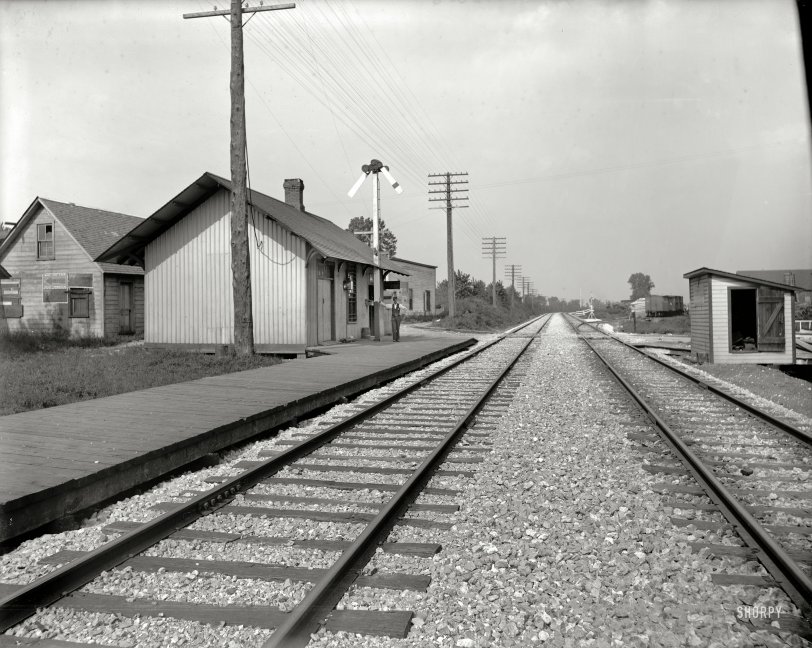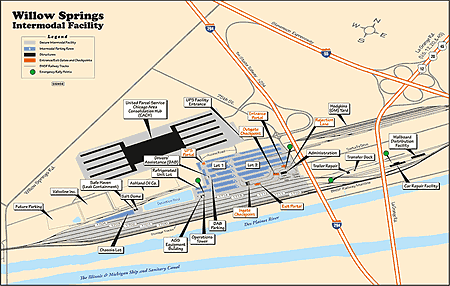


Framed or unframed, desk size to sofa size, printed by us in Arizona and Alabama since 2007. Explore now.
Shorpy is funded by you. Patreon contributors get an ad-free experience.
Learn more.

- Baldwin 62303
- Baldwin VO-1000
- Cold
- No expense spared
- Tough Guys
- Lost in Toyland
- And without gloves
- If I were a blindfolded time traveler
- Smoke Consumer Also Cooks
- Oh that stove!
- Possibly still there?
- What?!?
- $100 Reward
- Freeze Frame
- Texas Flyer wanted
- Just a Year Too Soon
- WWII -- Replacing men with women at the railroad crossing.
- Yes, Icing
- You kids drive me nuts!
- NOT An Easy Job
- I wonder
- Just add window boxes
- Icing Platform?
- Indiana Harbor Belt abides
- Freezing haze
- Corrections (for those who care)
- C&NW at Nelson
- Fallen Flags
- A dangerous job made worse
- Water Stop
Print Emporium
Willow Springs: 1900

Circa 1900. "Station at Willow Springs, Illinois." 8x10 inch dry plate glass negative, Detroit Publishing Company. View full size.
My Father's Predecessor?
There are two railroads that run through Willow Springs. I'm guessing that this is the Santa Fe depot.
My father was the Santa Fe Signal Maintainer at Willows Springs Ill. throughout the 1960's. I'm assuming this photo was taken facing north and that is Willow Springs Road crossing the tracks. Thank you for wonderful picture.
Train order signal
The train order signal is set for "clear" in both directions. If there were train orders or a message to be delivered, it would be set horizontally. This signal itself doesn't convey any information to a train about the condition or occupancy of the track ahead, and would be used only for messages. Great photo, the track appears immaculate.
The Semaphores
There are 2 semaphore signals seen. They are both what are known as 2 aspect semaphores. They can only indicate slow and stop. Further away in each direction you would find 3 aspect semaphore signals that would indicate either; proceed, slow or stop. Further down on the right is a mail pick-up device. I'm quite sure there is also one for the other track in back of the camera. The mail pouch is suspended from the arm and as the train goes by, an arm is extended from the mail car to snatch it and draw it inside. If there is mail for the station, it is tossed onto the platform. Commuter trains still stop at this location.
Electrically bonded
I noticed that the far left rail has bonding wires at the joint. For 1900 I am surprised to see that this line probably has some form of signalization. Whether that be for aspects or just track occupancy I can't tell. More than likely just to make a light light up or bell ring inside the station to let the station attendant know there was a approaching. I can see the wires on the left main, but don't see them on the track on the right, could be a siding.
As for the semaphores at the station, these were used for signaling the train to pick up train orders at the station; instructions for the crew for the next and/or subsequent sections of the line (where to take a siding for a meet, speed restrictions, construction, etc...)
There are two, one for each direction. Generally down indicated no need to stop or receive orders.
Repair List
Looks like the chimney could use a bit of work.
8 x 10 Glass Negatives.
I love photos from those 8 x 10 glass negatives. This one is focused a little close to the camera to be a great photo, and there are some scratches towards the bottom, but it is almost like you can step into the scene.
Not Bucolic Anymore
This Illinois town was chosen as the site of a large intermodal highway/rail terminal, because it was far enough away from Chicago's core to avoid congestion, but near enough to be convenient to the Interstate Highway systen.

Picnic at your own risk these days
One source reports that when railroad service was established between Willow Springs and Chicago, city folk used it to reach what was considered a nice place to picnic. How things have changed.
Today the community is host to a very large and busy highway interchange, including Interstate 294 (Chicago bypass), U.S. highways 12, 20 and 45, and Illinois 171. It also hosts, in part, a huge (2,130,000 square foot) United Parcel Service hub that processes 1.6 million packages a day, many of which are shuttled to the adjacent BNSF intermodal yard (another very large facility).
I assume the fellow in the image is the station agent, a prestigious position at the time. Perhaps some knowledgeable Shorpy reader can tell us what the indication is for the semaphore aspect. Proceed?
























On Shorpy:
Today’s Top 5